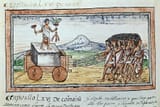Search Results
7/25/2025, 5:13:14 PM
>>17870640
>wheelbarrows and hand carts
They can't handle giant rocks. The use of these things in Europe is literally contemporary to the end of the Toltec Empire and beginning of Nahuatl/Mexica immigration.
>The first wheelbarrows in medieval Europe appeared sometime between 1170 and 1250. In contrast to the ones which typically have a wheel in the center of the barrow and were preferred in China, the types mostly used in Europe featured a wheel at or near the front, the arrangement of most wheelbarrows today
>Research on the early history of the wheelbarrow is made difficult by the marked absence of a common terminology. The historian of technology M.J.T. Lewis has identified in English and French sources four mentions of wheelbarrows between 1172 and 1222, three of them designated with a different term. According to the medieval art historian Andrea Matthies, the first archival reference to a wheelbarrow in medieval Europe is dated 1222, specifying the purchase of several wheelbarrows for the English king's works at Dover. The first depiction appears in an English manuscript, Matthew Paris's Vitae duorum Offarum, completed in 1250
>By the 13th century, the wheelbarrow proved useful in building construction, mining operations, and agriculture. However, going by surviving documents and illustrations the wheelbarrow remained a relative rarity until the 15th century. It also seemed to be limited to England, France, and the Low Countries
>The oldest wheelbarrows preserved from Central Europe were found in 2014 and 2017 during archaeological excavations in Ingolstadt, Germany. The felling dates of the trees that make up the wheelbarrow boards could be dendrochronologically dated to 1537 for one wheelbarrow and the 1530s for the other
>wheelbarrows and hand carts
They can't handle giant rocks. The use of these things in Europe is literally contemporary to the end of the Toltec Empire and beginning of Nahuatl/Mexica immigration.
>The first wheelbarrows in medieval Europe appeared sometime between 1170 and 1250. In contrast to the ones which typically have a wheel in the center of the barrow and were preferred in China, the types mostly used in Europe featured a wheel at or near the front, the arrangement of most wheelbarrows today
>Research on the early history of the wheelbarrow is made difficult by the marked absence of a common terminology. The historian of technology M.J.T. Lewis has identified in English and French sources four mentions of wheelbarrows between 1172 and 1222, three of them designated with a different term. According to the medieval art historian Andrea Matthies, the first archival reference to a wheelbarrow in medieval Europe is dated 1222, specifying the purchase of several wheelbarrows for the English king's works at Dover. The first depiction appears in an English manuscript, Matthew Paris's Vitae duorum Offarum, completed in 1250
>By the 13th century, the wheelbarrow proved useful in building construction, mining operations, and agriculture. However, going by surviving documents and illustrations the wheelbarrow remained a relative rarity until the 15th century. It also seemed to be limited to England, France, and the Low Countries
>The oldest wheelbarrows preserved from Central Europe were found in 2014 and 2017 during archaeological excavations in Ingolstadt, Germany. The felling dates of the trees that make up the wheelbarrow boards could be dendrochronologically dated to 1537 for one wheelbarrow and the 1530s for the other
Page 1
